Text
The Legacy of Frida Kahlo
Frida Kahlo is a Mexican born artist formerly remembered for her paintings, more specifically her paintings based on nature and Mexican culture as well as her many self-portraits. Kahlo took up painting whilst recovering for a bus accident she was in as a teenager, the accident left her in a full body cast for quite some time and painting was her way of distracting her from the pain of recovery. Her work is heavily inspired by her culture which she incorporates in the clothing and scenery that she depicts in her paintings. In her lifetime she completed over 140 paintings (55 of which being self-portraits). A common theme in Kahlo’s work is both physical and emotional pain, the physical pain coming from her multiple surgeries she had to undergo because of her accident and her emotional pain came from her rocky relationship with her husband, fellow artist Diego Rivera (who she married twice). Despite that Kahlo is recognised as one of the greatest artist Mexico has ever seen and has become on of the most widely known artist in the world.
Kahlo was born in Coyoacán, Mexico City on the 6th of July 1907 and her full name is Magdalena Carmen Frieda Kahlo y Calderón. Kahlo’s father was a photographer who immigrated from Germany to Mexico where he met her mother Matilde, she is the third child with her two older sisters Matilde and Adriana and her younger sister Cristina. Even before her accident Kahlo had problems with her mobility as she contracted polio at a young age that damaged her right foot and caused her to have a limp from the age of six. In 1922 Kahlo became one of the only female students to attend the renowned National Preparatory School in which she became very politically active and joined the Young Communist League and the Mexican Communist Party whilst still a student. Not long after (1928) she married fellow artist Diego Rivera in what would become a very rocky and unstable relationship going through several periods of separation and rekindling, it was this relationship that would inspire some of her most famous paintings.
Kahlo first exhibited her work in 1939 in an exhibit in Paris, her work received massive praise and not long after Kahlo was commissioned by the Mexican government for five portraits of important Mexican women in 1941, however she was unable to finish the project due to the passing of her father as well as her chronic health problems. In 1953 Kahlo got her very first solo exhibit in her home city and, despite being bedridden, she refused to miss the opening and arrived by ambulance to celebrate with attendee’s. After Kahlo’s passing in 1954 her work became the symbol for female creativity and helped fuel the feminist movement in the 70’s, it was such events that has made her artwork iconic. “Frida expresses her own experiences in her works, it is exactly what she is living in her present, how she interprets it and how she believes that others live it. She paints after her divorce, as already mentioned before, “Las dos Fridas”, which we can locate within Surrealism (1939), because the surrealists do not want to copy reality but prefer to capture their reality, which is what they interpret of her dreams, or in the case of Frida, her own experiences, since she was able to create wonderful works from them. (…) Frida differs from the surrealists because she does not pretend to paint her dreams or liberate the unconscious, but through the technique of surrealism expresses her own experiences, which emanate suffering.” – Galeria Valmar, artes visuals, 2019.

The Broken Column
For this next part I wanted to analyse some of Kahlo’s most famous paintings and explore the deeper meaning behind them, starting with ‘The Broken Column’. ‘The Broken Column’ was a self-portrait created in 1944 shortly after a spinal surgery Kahlo underwent due to her accident, the surgery left her in a full body cast and a spinal brace which can be seen in the painting. Also in the painting we can see her body appearing almost cut in half, as if her spine had been ripped out, as well as nails poking out of her body. This actively demonstrates the physical pain constant years of surgery has caused Kahlo with the nails being a physical representation of such. Through the centre of her body the column taking the place of her spine is broken in several places creating the effect that it’s about to crumble and collapse on itself. Almost all of Kahlo’s self-portraits are meant to display her suffering caused by her accident, which left her both unable to bear children and ended her dreams of becoming a doctor, this is often shown by her facial expressions with ‘The Broken Column’ being no exception. After a closer look you can tears falling down her face as well as strong highlights in her pupils to emphasise the physical and emotional pain she was suffering. “The Broken Column was painted shortly after Frida Kahlo had undergone another surgery on her spinal column. The operation left her bedridden and “enclosed” in a metallic corset (…) The accident ended Kahlo’s dreams of becoming a doctor and caused her pain and illness for the rest of her life. (…) Although her face is bathed in tears, it doesn’t reflect a sign of pain. The nails piercing her body are a symbol of the constant pain she faced.” – Zuzanna Stanska, The daily art magazine, 2017.
Some people also believe that this painting is not just a representation of the pain Kahlo endured because of her health, many believe that it is also a commentary on the emotional pain caused by her unstable marriage. Most of the Kahlo’s most iconic pieces are inspired by her suffering and serves as a visual representation to her inner thoughts and emotions, her marriage being a large source of suffering throughout her lifetime. Some view the fragmented column lodged in her chest to be fragments of her marriage impaling her. “Despite the somewhat in-your-face symbolism, this is a favourite subject for bad art theory papers, identifying the column as everything from her fragmented marriage to a giant phallus penetrating her body. While such interpretations could be partially true, we think that sometimes a spinal column is just a spinal column (…) She referred to her medical ordeal as her “punishment.” She also took her tragedy in good humour, saying of this painting, “You must laugh at life...Look very closely at my eyes...the pupils are doves of peace. That is my little joke on pain and suffering…” Some claim the larger nails over her heart reflect her tortured relationship with Diego Rivera.” – Griff Stecyk, Startle, 2019.

Thinking about death
The next painting I have chosen to analyse is titled ‘Thinking of Death’ which is a self portrait created in 1943. This painting was created around the time Kahlo’s health really began to deteriorate as it depicts herself surrounded by nature with a small skull in her for head. Kahlo painted herself in very traditional clothing with her hair done up in a bun. The skull depicted in her forehead is supposed to represent the fears Kahlo had due to her health battles, with how sick she was death was a constant thought for her with it having come so close multiple times in her life. In Mexican culture death can mean the rebirth of life with is meant to be represented by the lively green leaves behind her as well as her facial expression which shows no sign of fear or panic suggesting Kahlo’s acceptance of death being another part of life. “Due to her poor health condition, death is an inevitable thought which lingering over her mind. In this painting, death is symbolized as skull and crossbones which shows up in her forehead. In ancient Mexican culture, death also means rebirth and life.” – FridaKahlo.org, 2017.
The skull itself represents the thought of death and sits right were ones third eye would be, this suggests that maybe Kahlo views the thought of death as some kind of wisdom instead of a fear, although Kahlo never wished to be labelled as a surrealist artist as her paintings come from her reality. “In Kahlo’s collective work, death seems to pervade almost every one of her paintings as an expression of pain, or a motif of oppression concerning female gender roles. Kahlo employs an almost anatomical eye in looking at her form, juxtaposing it beside images of adorned skeletons.” – MaryFrances Knapp, Seven Pounds, 2017.

Self Portrait with Thorn Necklace and Hummingbird
The final painting I have chosen to analyse is titled ‘Self-portrait with Hummingbird and Thorn Necklace’ which is another self-portrait completed in 1940. In this painting Kahlo is surrounded by animals such as a monkey and a black cat with a large necklace of thorns around her neck, in the thorns there is a hummingbird tangled amongst them. She is also surrounded by green leaves much like ‘Thinking about Death’ with insects like dragonflies and butterflies in her hair, with a blue sky barely peaking behind the leaves. The painting was completed soon after Kahlo’s messy divorces with Rivera following the theme of suffering throughout her paintings. The thorns around her neck could be a visual representation of how it felt to grieve her relationship much like the nails did in ‘The Broken Column’, though it could have a religious meaning referring to Jesus’s crown of thorns. Kahlo also incorporates Mexican culture into this piece with each animal representing something different that is relevant to the context of the painting with hummingbirds symbolising love, black cats symbolising bad luck, Dragonflies symbolising prosperity and monkeys symbolising lust. “This self-portrait was created following Kahlo’s divorce to Diego Rivera (…) There are obvious religious overtones to the piece using Jesus’s crown of thorns. Kahlo has painted herself as a Christian martyr, enduring the pain of her failed marriage (…) In Mexican culture, hummingbirds signify falling in love and are used in love charms (…) Kahlo often used vibrant flora and fauna as backgrounds for her self-portraits, to create a claustrophobic space teeming with fertility. It is thought that the emphasis of her monobrow and moustache – with the lines of her eyebrows mimicking the wingspan of the hummingbird around her neck – was intended as a feminist statement.” – Tara Lloyd, Singul art Magazine, 2019
This painting is a great look into Kahlo’s attention to detail and how every piece of her paintings represents something, she is very in touch with her culture and has great understanding as how to show her emotions and life experiences in each of her pieces. “Like many other of her paintings, this artwork is a lot akin to a painted assortment of symbols. Every element in this painting gives specific clues to Kahlo's mental state, perhaps none more than her still, direct, emotionless gaze that seems to express the immediacy of her pain.” Audrey V, Wide Walls, 2018
To sum up everything thus far Frida Kahlo is an incredible artist who poured her life into her work, her pain and passion has made her paintings so iconic in this modern age. She has become a symbol not only for Mexican artists but female artists as well, paving the way for many like her in the years to come. In response to why she painted so many self-portraits Kahlo responded, “I paint self-portraits because I am so often alone, because I am the person I know best”.
Bibliography
Galeria Valmar, artes visuals, 2019
Zuzanna Stanska, The daily art magazine, 2017.
Griff Stecyk, Startle, 2019.
FridaKahlo.org, 2017
MaryFrances Knapp, Seven Pounds, 2017
Tara Lloyd, Singul art Magazine, 2019
Audrey V, Wide Walls, 2018
12 notes
·
View notes
Text
Photo Essay
The Photographer I have chosen to study is Sylvia Jarrus who is an American born photographer and is a member of Authority collective and Diversify photo. I want to focus on her most reason work that captures the chaos of politics in America during 2020 which includes photos showing the impact of the corona virus and the result of its poor handling. Specifically I want to focus on her phots that puts a name and face to the specific groups that have been suffering the most during this difficult time.


The context behind these photos was a response to the way students were being treated throughout the Corona Virus Pandemic, the first photo depicts a student left without any clear plans going forward by the Governments response to the virus and the second was taken for an article about the financial burden placed on schools to buy masks and other medical equipment to ensure staff and student safety. The description under the first photo reads “Just weeks before Michael Stone, 27, was set to begin his senior year at Marygrove College in northwest Detroit they announced after 112 years, their undergraduate programs would end after the coming semester. The closings displaced hundreds of students. Stone was unable to finish his bachelor’s degree in Music and only left with an associate degree”. The whole pandemic has hit the world extremely hard leaving over 2.65 million people dead and forcing the closure of 60% of businesses worldwide, it’s clear that the government had no clear plan when the virus had it’s first outbreak in Beijing, China in early 2020. One group that feels particularly pushed aside and forgotten about are students and the aim of this photo is to turn students from a statistic to real humans with problems that need to be catered to.

The next photo I have decided to focus on the new COVID-19 vaccine, the picture shows a woman in Oakland county receiving her first dose of the vaccine. The description reads “Margaret McCarthy, an Oakland county nurse places a dose of the Moderna vaccine into a needle on Saturday, Jan. 23, 2020 at the Suburban Collection Showplace in Novi, Michigan. Oakland County Health Division employees inoculated about 3,400 Michigan residents who were over 65 and/or essential workers”. The vaccine was the first real break through we had with the virus and is currently the only hope we have on returning things back to the way they were as despite the governments best efforts the virus only continued to spread and mutate over time. The photo also speaks on the way essential workers have been treated throughout the pandemic as medical workers have recently been forced to work extremely long hours with no days off the help assist the mass amounts of people who have been hospitalised due to the disease.
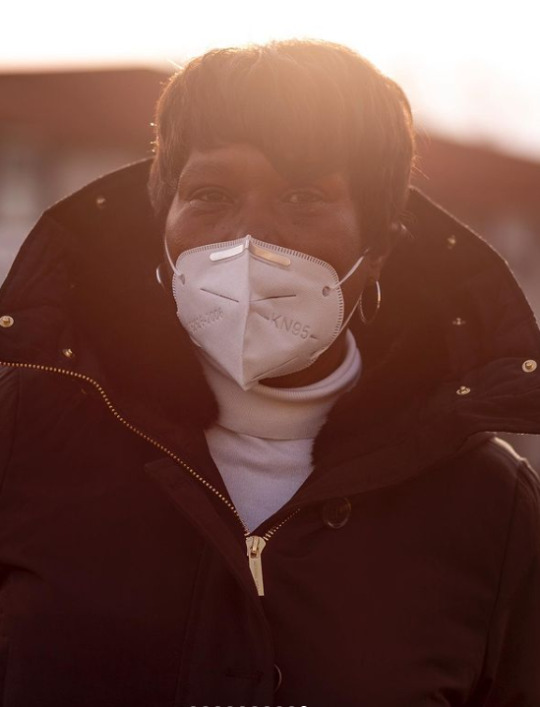
The final photo tries to convey the difficulties people have faced with their medical battles ever since COVID-19 took over the medical scene, the description reads “Judy McCray, 63, was Face Timing with her sister Deloris Curry, 69, a resident at Westwood Nursing Centre in Detroit Michigan and was shocked to see a staff member enter the room without a mask. This was several months into the pandemic and she hadn’t been to visit her sister since February. In 2018 Deloris had an above the knee amputation due to an infection caused by a knee replacement surgery, and they decided to move her to the home hoping for rehabilitation services where her sister could learn to use her new prosthesis. That never happened. Years later, Deloris hasn’t received the necessary therapy and rehabilitation she needs and isn’t able to use her prosthetic.” The photo shows a 63-year-old woman who has been unable to she her family or receive the medical attention she needs because of who underfunded and poorly planned the medical field has been during this difficult time. The photo tries to show the different ways this situation has effect peoples lives and how the ones with the sickness aren’t the only victims.
0 notes
Text
On Photography Essay
In the novel ‘On Photography’ by Susan Sontag, the author talks about the importance of context behind photographs. She uses the famous Photographer Diane Arbus as an example as she talks about how Arbus’s suicide changes the way her photos are viewed, “Her suicide also seems to make the photographs more devastating, as if it proves the photographs to have been dangerous to her” (On Photography – Susan Sontag, page 31). Sontag describes Arbus’s photos as almost sad to look at as if you could piece together the reason why she took her life just by looking at her work and I do agree that someone’s work can be a great window into their mind and emotions especially if the work comes straight from there head.
Later in the paragraph Sontag talks about the length photographers would go to get certain shots using war photographers as an example, desperate to show people what it was like. “Only war photographers combine voyeurism and danger. Combat photographers can’t avoid participating in lethal activity they record; (…) to discover (through photography) that life is “really a melodrama” to understand a camera as a weapon of aggression, implies there will be casualties” (On Photography – Susan Sontag, page 31). This passage describes photographers risking their life to document war zones, Sontag even mentions that they would “even wear military uniforms, though without the rank badges” (On Photography – Susan Sontag, page 31). This is another layer of context behind photos that can change the way we view an image, not only do I see a war zone (when I look at these images) I feel like I can also understand the emotions of the person behind the camera.
Personal Image

This picture was taken in 2007 when me and my family visited Hadley farm for a day out. I was 5 years old and my sister was 7 years old. I think I was too young to remember this day so I’m not 100% sure on the context behind it but I do know that some time around this photo being taken I innocently tried to feed one of the goats only to have it rip the whole bag of food from my hand, I remember I wasn’t very happy about that.
0 notes
Text
We The People - Frank Shepard Fairey Essay
Frank Shepard Fairey is an American illustrator and graphic design, who is more commonly known for his politically charged art. His first piece to gain recognition was his piece titled ‘Andre the giant has a posse’ which became a street art campaign in 1989. The piece is a graphic portrait of a professional French wrestler and was soon plastered around cities worldwide thanks to the skateboarding community at the time. However this isn’t Fairey’s most famous piece. The most iconic piece of work Fairey has produced has to be his 2008 Hope poster for Barack Obama’s presidential campaign, this piece has reached global recognition becoming a pop culture phenomenon and the main image for Obama’s campaign. The poster is a monochromatic portrait of Obama and although the bottom text is sometimes change to either “progress” or “change” the original has the word “hope” written underneath in bold blue text. Fairey created the poster after seeing a speech in 2007 where Obama’s political views aligned with his and he was delighted to hear that he would be a presidential candidate in the 2008 election. The poster was created to help push the campaign and feared that his reluctance surrounding the election would be ‘problematic’ for him as a street artist. “I decided to make a portrait of Obama largely because I felt his power and sincerity as a speaker would create a positive association with his likeness. I wanted it to be a portrait that was political in nature and that would de-racialize Mr. Obama by using a red, white, and blue colour palette that was patriotic”, Frank Shepard Fairey – Medium.
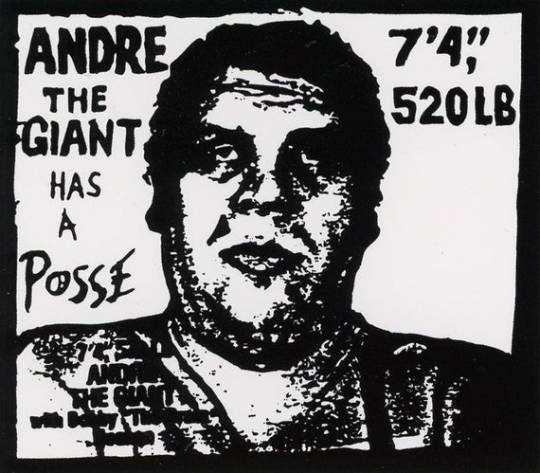
‘Andre the giant has a posse’ - Frank Shepard Fairey
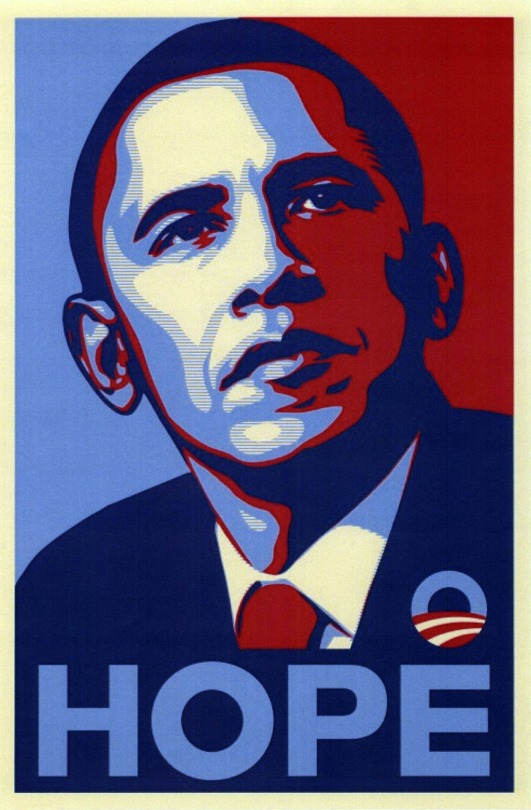
‘Hope’ - Frank Shepard Fairey
The collection of art that made me want to study Fairey in more detail is his recent Donald Trump inauguration posters. The art itself is very alike to the Obama poster (portraits with the red, blue and beige colour scheme) however the story behind them is the complete opposite. There out of the five posters for this campaign where done by Fairey, those posters are portraits of women (all of which are POC’s) with the words “We the People” written underneath, one depicts a Muslim woman wearing a hijab with the American flag printed on it. The 4th poster was done by Ernesto Yerena (a Mexican artist who has created many political posters throughout his career) and shows what appears to be an elderly Native American woman with one fist raised in the air (this pose has become the symbol for equality and equal rights even becoming the symbol for the recent black lives matter movement), the words “We the Resilient have been here before” is written above. The final poster was done by Jessica Sabogal (a queer Columbian – American artist who is well known for her stencil and spray paint art) and shows two women in an embrace, alluding to and more than platonic relationship, with the words “We the Indivisible” written underneath.
Fairey’s goal with these posters was to oppose Trump by depicting protagonists of the most vulnerable groups in America (those of which being Muslims, Latinos, African Americans and members of the LGBTQ+ community) and use them as the faces of a patriotic American campaign. Fairey even went as fair to have each model shot by a photographer who related to their identity. A spokes person for the Amplifier foundation commented about the campaign telling them “We the People is a broadcast campaign that uses visuals to lift up those who have been insulted, and to pair each image with a value that we cannot lose sight of, like ‘defend dignity’ or being ‘greater than fear”, Mark Gonzales – Quartz
The 3 portraits of woman are remarkably similar to Fairey’s previous work and is clear inspired by his 2008 Obama poster, each on has the phrase “We the People” written underneath with another phrase below that which is unique to each poster. "We thought (they) were the three groups that had been maybe criticized by Trump and maybe were going to be most, if not necessarily vulnerable in a literal sense, most feeling that their needs would be neglected in a Trump administration,", Frank Shepard Fairey – CNN. The poster with the Muslim woman depicts her in an American flag printed hijab which is in reference to the racism that refugees and immigrants face when migrating to safer countries such as the US, and although many Muslim’s and POC’s are born in these countries they are mad to feel as if they don’t belong (which was a statement that was promoted heavily by Trump especially during his presidential campaign in 2015).

‘We The People’ - Frank Shepard Fairey
The other two posters, although not done by Fairey, are still just as important to this campaign so I want to analyse their work too starting with the piece done by Ernesto Yerena. Yerena is a Mexican artist who created the poster of the Native American woman, the piece is titled “we the resilient”. I’m a really big fan of this piece mainly for the way he used colour theory to push the figure forward and make it stand out as the focal point of the image. The way he used warm tones in the woman and had an ombre blue sky behind her made the piece really stick in my mind and gave the piece a very lively look to it. The woman in the piece is named Lakota elder Helen “Granny” Redfeather and this shot of her was taken whilst she was protesting the Dakota Access Pipeline at Standing Rock, she was used in this campaign as the Native Americans are a small and often forgotten group who dealing with oppression just like any other minority, also with Trump making many insulting comments about them and attempting to revoke land from the Natives during his presidency. “My relationship with the U.S. is very complicated… I was born here, I live here, but the government is like an occupying force on this land. The colonization process was so violent. It outlawed people from being able to practice Indigenous traditions and languages. How, through all that, have people been able to survive? Considering how hostile the attempted erasure was toward everything to do with our people, Indigenous people, it’s incredible. That’s resilience.”, Ernesto Yerena – Colourlines
The final poster for this campaign is the poster of two woman embracing by Jessica Sabogal. Sabogal herself is a queer artist so she chose to represent the LGBTQ+ community by depicting two women in what appears to be a happy and loving relationship, with almost love-struck gazes on their faces. With this poster Sabogal only used colours in the background image leaving the figures black and beige to push them forward in the opposite way that Yerena did with his piece. Sabogal chose to represent the LGBTQ+ community as they have received heavy amounts of criticism from Trump who was not shy about his lack of support for the community in several interviews as well as banning trans individuals from joining the army. In short, all posters show woman who are apart of an oppressed group and uses them as the faces of a patriotic campaign to give power and voices to woman just like them who society pushes down.
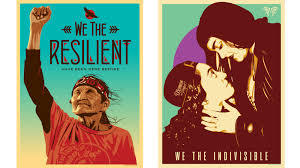
‘We The Resilent’ - Ernesto Yerena
‘We The Indivisible’ - Jessica Sabogal
0 notes
Text
Manifesto Group Project Experience Essay
I really enjoyed working on this project, because of the subject matter we chose and how we we’re able to make our essay humorous we were all very enthusiastic about what we were planning to write. We first got the idea for last minute essays in a conversation we had about a different piece of homework we had for the same class and how we all pretty much waited until we couldn’t ignore the task any longer to complete it. I remember when the idea was suggested and we were all jotting down ideas whilst giggling away to ourselves, I felt myself actually being excited to start writing which was a really refreshing feeling to have. I think the three of us worked well as a group as we all pulled our own weight and added something new and unique to the project, we started out by completing the task ourselves and the joining all our versions together to create the completed essay (both versions have been uploaded to this blog).
As a group we had good communication and we we’re almost always on the same page when it came to our ideas which help all of our individual essays blend nicely into one. Overall I had a really great time working on this project and would definitely love to work in groups again.
0 notes
Text
Close Call (Individual Manifesto)
Rule 1 – You must start your assignment at least 24 hours before the deadline
The best way to produce your highest quality of work is to put a huge load of pressure on your shoulders by waiting until the deadline is fast approaching and you physically cannot put off the task any longer. I mean think about it, if you try to complete a task with no sense of urgency how do you remain invested? How do you stop yourself from being distracted? An ever so nearing deadline is sure to keep you focused. The fear of not being able to complete the task in time will keep you own your toes and insure you use every ounce of your time wisely and that you will put everything you have into this essay. That’s the best way to insure you produce high quality work.
Picture this, it’s the day after your task has been set and you have decided to get your work done early, you take your time setting up you work space, you get yourself a snack and a warm beverage and now you can take your time and write out your essay. You’ll be there for years! Constantly giving yourself breaks, thinking about what you’re writing, constantly second guessing and changing you’re points. Not officiant at all! Your mind will be all over the place! Fear is going to be the best motivator here. I mean, what’s the worst that could come from that? You might get overwhelmed by stress? Trust me on this one, leaving it until the last minute is the more officiant choice.
Rule 2 – keep it unrealistic, in the movies the least likely to survive always makes it till the end
If there is one thing we all know is that the best place to get our logic from is movies, and if there is one trait that pops up over and over again, it is that the under dog always makes it out on top. It’s a classic trope where the main character must fight to beat the odds stacked against them to come out on top, it happens so often in media surely there must be some truth behind it! Take these classic examples: Rocky, Glory Road, Cinderella Man, Slum Dog Millionaire, School of Rock, 300. All classic films with one common trait, the main character starts off with little to no chance of winning, but they still pull through in the end. This is the mindset you need to have whilst working on your essay, you’re the main character of your story after all, so why not make the story a bit more interesting? Put the audience on edge for a bit. Leaving all your work to the last minute is a great way to add tension and defiantly will make sure the odds are not in your favour. Some other things you can do to decrease your odds of success is using an old and unreliable computer to type and submit your work on (got to keep the audience on their toes remember).
Not only will decreasing odds make your night more interesting but imagine how good it will feel when you inevitably beat the odds and finish in the nick of time. The sense of accomplishment you will feel when you type that final full stop will defiantly be worth all the stress and pressure you put on yourself beforehand, imagine all that weight slowly being lifted off your shoulders, just imagine how good it will feel. In my opinion, all the unnecessary stress from when you started is defiantly worth it to get that feeling.
Rule 3 – don’t check it, don’t proofread it, just keep writing
Checking and proofreading your work is just going to slow you down, did you forget you only have a few hours to get this done? Yes, there might be spelling mistakes and grammatical errors in your writing sure, however, there might also not be any mistakes and that little bit of time you save is 100% worth the risk. Remember, this is a race against time. I mean think about it, if you called it a night the second you’ve typed that last full stop, you might even get enough time to have a full hour sleep before you need to turn it in! Right now, anything that will save you time is essential, so don’t waste your time re-writing what you’ve already written especially since isn’t it the teachers job to correct mistakes anyway?
Also, maybe you need to be a bit more confident in your writing abilities, how can one be confident if they’re constantly assuming that they’ve made tons of grammatical mistakes? Sounding confident in your writing is the best way to convince your teacher that you really took you time a researched the topic you’re writing about. So, cut yourself some slack every once and a while, I’m sure it will be fine.
Rule 4 – make it all up at the end, the best ideas always come at the end anyway
Put yourself in your teachers position for a moment and think, how many other students are there in my class again? And that is exactly how many essays your teacher has to read and mark as soon as you hand it in next lesson. That’s a lot of words! Are they really going to sit there and read every single word, of every single essay, for every single student? No way! I mean, you couldn’t even sit still and write one essay, let alone 20. This is something we can use to our advantage especially when it comes to the end of our essays. By the final paragraph it’s safe to assume that the teacher has lost interest by now (lord knows you have) so why give yourself more work? Just make it all up! No need to fact check anything your writing, people will believe anything as long as you sound like you know what you’re talking about, I’m sure a teacher who studied this subject for years and probably went to some specialised school for it will fall for this trick too.
You’ll usually find that the best ideas come at the end anyway, you’ll probably find that you’re spoiled for choice when it comes to your final paragraph. Of course this doesn’t mean you should re write any of the other points you made in a previous paragraph (refer to rule 3) not when you put so much time into them. If all the last-minute ideas are too good to not include, I’m sure just cramming them all into one paragraph will do them all justice.
Rule 5 – always work in the dark, preferably after 12:00 AM
No, you could work at a normal, reasonable time like most people do, or, you can do it the less popular (but just as officiant) way of working which is waiting until everyone else is sleeping or at least winding down for the night, to complete all your assignments. This is going to be especially important if you live in a busy household with lots of people around, can you really expect to work to the best of your ability with your family making all that racket? Of course not! Besides staying up all night is far easier than asking them to just keep it down, you don’t want to put any extra stress on to yourself like that. But it’s not just your family that can distract you, if you live on a busy street or by a busy road, that is certainly going to impact your progress. Just waiting until the streets are dead and the world is asleep should give you the peace and quite you need. But that’s not the only benefit to working in the dead of night.
Personally, I think working in total darkness with your laptop as the only light source in the room and being the only thing you can physically see, is a very officiant way to work. It comes back to getting rid of all those distractions (remember you can’t afford to get distracted this time) this way the only thing you can look at is what you need to focus on. So switch of all lights, even night lights, to increase your chances of completing your essay in the time that you have left.
Rule 6 – don’t set an alarm, rely on your wits to wake you up
Let’s put this out there. Everyone hates alarms. They’re load, they’re annoying and waking up is the most agonising feeling one can ever feel. We all despise them. So why set them? When your body is ready to wake up, it’ll wake up naturally and it’s best not to disturb nature. I mean think about it, you’ve been stressing about this deadline more than anyone else, surely you know it off by heart now, and your body knows it to! Surely you body knows how important this deadline is and will wake you up with the perfect amount of time left to get ready for the submission, right? I’m certain that the amount of stress you have voluntarily put yourself under will let your body know exactly what time you need to get up. It’s a risk that will defiantly be worth taking in the long run.
Besides if, in the unlikely event, you don’t wake up in time then clearly it just wasn’t meant to be. Right now you are exactly where you need to be and I’m sure if you where really supposed to be up and ready the universe would have found away. I think that’s a valid excuse that will defiantly hold up in a classroom.
Rule 7 – don’t sleep beforehand, you might be too tired to care
If there’s going to be a time where your most likely to call it quits and except defeat, it’s going to be when you’re in the sheets. Now I can understand why, it’s comfortable, it’s warm, it’s the only place where you can get away with lying down and doing nothing for hours on end, it’s just a nice place to be, which is why you need to avoid it at all costs. You’re not going have the motivation to get up and write an essay once you’ve been subjected to the comfort that is your bed, as soon as your head touches that pillow it’s pretty much game over for you. You’re not getting up. So you need to make sure your up and active for when you start to tackle this task, maybe take a cold shower, maybe chug some coffee, anything to make sure that you not going to be tempted. Don’t even work on it! Work on the floor if you must! Even being near it is a temptation you can’t risk getting lured into, it’s an easy trap to fall for.
In the likely event you find yourself in bed yet somehow you still have the will power to continue, there are a few things you can do to help pull you back in the race. The trick is to act quickly, save up all your strength for one big boast of energy to push your body forward. The longer you wait the heavy your body will get and harder it will be to continue. So, take a deep breath, count down from five and swing your body with all your strength, and finish your damn essay!
0 notes
Text
Close Call (Completed Manifesto)
We’ve all been there - when you have mere hours to complete a 1,000 words project and you wish you were Speedy Gonzales, but don’t worry – Close Calls has got you covered. With these archaic techniques for waffling, as practised by our predecessors, you’ll be able to finish an essay in just under 12 hours.
These are the 7 rules that ensure you can successfully complete all nights without, you know, dying.
(HAPPY FACE)
CLOSE CALL MANIFESTO – THE 7 RULES OF PROCRASTINATION
1.You must start your assignment at least 24 hours before the deadline
2.Keep your chances of success at 0% – you might just surprise yourself
3.Don’t check it, don’t proof-read it, just keep writing
4.Always work in the dark, preferably after midnight
5.Don’t sleep or you might be too tired to care
6.If you do sleep - Don’t set an alarm, rely on your wits to wake you up
7.Make it up at the last minute – that’s when the good ideas come
Rule No 1 - You must start your assignment at least 24 hours before the deadline
The Concise Guide
Fear is your friend!
The Somewhere in the Middle Guide
Nothing motivates more than the fear of failure. By leaving yourself 24 hours you can kickstart your drive to work whilst giving yourself enough time to procrastinate for half the day
(CHEEKY SIDE EYE FACE)
The Complete Guide
The best way to produce your highest quality of work is to put a huge load of pressure on your shoulders by waiting until the deadline is fast approaching, and you physically cannot put off the task any longer. I mean think about it, if you try to complete a task with no sense of urgency how do you remain invested? How do you stop yourself from being distracted? An ever so nearing deadline is sure to keep you focused. The fear of not being able to complete the task in time will keep you own your toes and ensure you use every ounce of your time wisely and that you will put everything you have into this essay. That’s the best way to ensure you produce high-quality work.
Picture this, it’s the day after your task has been set and you have decided to get your work done early, you take your time setting up you workspace, you get yourself a snack and a warm beverage and now you can take your time and write out your essay. You’ll be there for years! Constantly giving yourself breaks, thinking about what you’re writing, constantly second-guessing and changing your points. Not officiant at all! Your mind will be all over the place! Fear is going to be the best motivator here. I mean, what’s the worst that could come from that? You might get overwhelmed by stress? Trust me on this one, leaving it until the last minute is the more officiant choice.
Rule No 2 - Keep your chances of success at 0% – you might just surprise yourself
The Concise Guide
When your expectations are so low, the only real way is up.
The Somewhere in the Middle Guide
Why? Think about it like this – in movies/stories just when you think the hero is about to lose they win. In horror, the character whom you think will die, lives (well, most of the time anyway). Don’t be overconfident and don’t relax too much or you’ll raise a death flag – or in your case a fail flag
(HAR HAR FACE)
The Complete Guide
If there is one thing we all know is that the best place to get our logic from is movies, and if there is one trait that pops up over and over again, it is that the underdog always makes it out on top. It’s a classic trope where the main character must fight to beat the odds stacked against them to come out on top, it happens so often in media surely there must be some truth behind it! Take these classic examples: Rocky, Glory Road, Cinderella Man, Slum Dog Millionaire and 300. All classic films with one common trait, the main character starts off with little to no chance of winning, but they still pull through in the end. This is the mindset you need to have whilst working on your essay, you’re the main character of your story after all, so why not make the story a bit more interesting? Put the audience on edge for a bit. Leaving all your work to the last minute is a great way to add tension and defiantly will make sure the odds are not in your favour. Some other things you can do to decrease your odds of success is using an old and unreliable computer to type and submit your work on (got to keep the audience on their toes remember).
Not only will decreasing odds make your night more interesting but imagine how good it will feel when you inevitably beat the odds and finish in the nick of time. The sense of accomplishment you will feel when you type that final full stop will be worth all the stress and pressure you put on yourself beforehand, imagine all that weight slowly being lifted off your shoulders, just imagine how good it will feel. In my opinion, all the unnecessary stress from when you started is worth it to get that feeling.
Rule No 3 - Don’t check it, don’t proof-read it, just keep writing
The Concise Guide
Your time is precious, especially now. Do not waste it! Worry about your structure later.
The Somewhere in the Middle Guide
Why waste your time reading when you could be writing more? Priorities people! Write until you reach the World Cup for your task then if you can’t leave that pesky spelling error alone, read it. However, be warned – you may get bored.
(BORED SLEEPY FACE)
The Complete Guide
Checking and proofreading your work is just going to slow you down, did you forget you only have a few hours to get this done? Yes, there might be spelling mistakes and grammatical errors in your writing sure, however, there might also not be any mistakes and that little bit of time you save is 100% worth the risk. Remember, this is a race against time. I mean think about it, if you called it a night the second you’ve typed that last full stop, you might even get enough time to have a full hour sleep before you need to turn it in! Right now, anything that will save you time is essential, so don’t waste your time re-writing what you’ve already written especially since isn’t it the teachers' job to correct mistakes anyway?
Also, maybe you need to be a bit more confident in your writing abilities, how can one be confident if they’re constantly assuming that they’ve made tons of grammatical mistakes? Sounding confident in your writing is the best way to convince your teacher that you really took you time a researched the topic you’re writing about. So, cut yourself some slack every once and a while, I’m sure it will be fine.
Rule No 4 - Always work in the dark, preferably after midnight
The Concise Guide
The neighbour's baby has finally stopped crying and now it's just you and the moonlight. Embrace the peace and quiet.
The Complete Guide
Now, you could work at a normal, reasonable time as most people do, or you can do it the less popular (but just as efficient) way of working which is waiting until everyone else is sleeping or at least winding down for the night, to complete all your assignments. This is going to be especially important if you live in a busy household with lots of people around, can you really expect to work to the best of your ability with your family making all that racket? Of course not! Besides staying up all night is far easier than asking them to just keep it down, you don’t want to put any extra stress on to yourself like that. But it’s not just your family that can distract you, if you live on a busy street or by a busy road, that is certainly going to impact your progress. Just waiting until the streets are dead and the world is asleep should give you the peace and quiet you need. But that’s not the only benefit to working in the dead of night.
Personally, I think working in total darkness with your laptop as the only light source in the room and being the only thing, you can physically see, is a very officiant way to work. It comes back to getting rid of all those distractions (remember you can’t afford to get distracted this time) this way the only thing you can look at is what you need to focus on. So switch of all lights, even night lights, to increase your chances of completing your essay in the time that you have left.
Rule No 5 - Don’t sleep or you might be too tired to care
The Concise Guide
There’s no time for that snooze button and a comfy bed now.
The Complete Guide
If there’s going to be a time where your most likely to call it quits and accept defeat, it’s going to be when you’re in the sheets. Now I can understand why, it’s comfortable, it’s warm, it’s the only place where you can get away with lying down and doing nothing for hours on end, it’s just a nice place to be, which is why you need to avoid it at all costs. You’re not going have the motivation to get up and write an essay once you’ve been subjected to the comfort that is your bed, as soon as your head touches that pillow it’s pretty much game over for you. You’re not getting up. So you need to make sure your up and active for when you start to tackle this task, maybe take a cold shower, maybe chug some coffee, anything to make sure that you not going to be tempted. Don’t even work on it! Work on the floor if you must! Even being near it is a temptation you can’t risk getting lured into, it’s an easy trap to fall for.
In the likely event you find yourself in bed yet somehow you still have the will power to continue, there are a few things you can do to help pull you back in the race. The trick is to act quickly, save up all your strength for one big boost of energy to push your body forward. The longer you wait, the heavy your body will get and harder it will be to continue. So, take a deep breath, count down from five and swing your body with all your strength, and finish your damn essay!
Rule No 6 - If you do sleep - Don’t set an alarm, rely on your wits to wake you up
The Concise Guide
Anxiety is nature's alarm clock.
The Complete Guide
Let’s put this out there. Everyone hates alarms. They’re loud, they’re annoying and waking up is the most agonising feeling one can ever feel. We all despise them. So why set them? When your body is ready to wake up, it’ll wake up naturally and it’s best not to disturb nature. I mean think about it, you’ve been stressing about this deadline more than anyone else, surely you know it off by heart now, and your body knows it too! Surely your body knows how important this deadline is and will wake you up with the perfect amount of time left to get ready for the submission, right? I’m certain that the amount of stress you have voluntarily put yourself under will let your body know exactly what time you need to get up. It’s a risk that will defiantly be worth taking in the long run.
Besides if, in the unlikely event, you don’t wake up in time then clearly it just wasn’t meant to be. Right now you are exactly where you need to be and I’m sure if you were really supposed to be up and ready the universe would have found away. I think that’s a valid excuse that will defiantly hold up in a classroom.
Rule No 7 - Make it up at the last minute – that’s when the good ideas come
The Concise Guide
It’s all in there somewhere. You’ve just got to find it before daylight finds you.
The Somewhere in the Middle Guide
Ah, it’s always in the last hour before a deadline when God decides to bestow the greatest ideas you never thought of. Then, (realising you only have 60 minutes till judgement day) you frantically delete those last three garbage paragraphs. Close callers are almost envied on their ability to cultivate outrageously ingenious ideas when a deadline is just around the corner. You should try it sometime, you never know…
(SMUG FACE)
The Complete Guide
Put yourself in your teachers' position for a moment and think, how many other students are there in my class again? And that is exactly how many essays your teacher has to read and mark as soon as you hand it in the next lesson. That’s a lot of words! Are they really going to sit there and read every single word, of every single essay, for every single student? No way! I mean, you couldn’t even sit still and write one essay, let alone 20. This is something we can use to our advantage especially when it comes to the end of our essays. By the final paragraph it’s safe to assume that the teacher has lost interest by now (lord knows you have) so why give yourself more work? Just make it all up! No need to fact-check anything your writing, people will believe anything as long as you sound like you know what you’re talking about, I’m sure a teacher who studied this subject for years and probably went to some specialised school for it will fall for this trick too.
You’ll usually find that the best ideas come at the end anyway, you’ll probably find that you’re spoiled for choice when it comes to your final paragraph. Of course this doesn’t mean you should rewrite any of the other points you made in a previous paragraph (refer to rule 3) not when you put so much time into them. If all the last-minute ideas are too good to not include, I’m sure just cramming them all into one paragraph will do them all justice.
0 notes
Text
Manifesto Essay
A manifesto is described as “a public declaration of policy and aims, especially one issued before an election by a political party or candidate”, however in art a manifesto is seen as a way for artists to show their true intentions behind their work such as their views on specific artistic movements. An example of a famous artist manifesto would be the one titled ‘The Stuckists’ by artists Billy Childish and Charles Thomson.
This piece was representing their beliefs against conceptualism, hedonism and the cult of the ego-artist. The piece includes a series of abstract paintings depicting figures with a series of different accessories such as umbrellas and top hats, the pieces are very vibrant and uses a wide range of colours to make up the image. There is little detail in the background which is just made up of different colour brush strokes and does not appear to resemble anything.
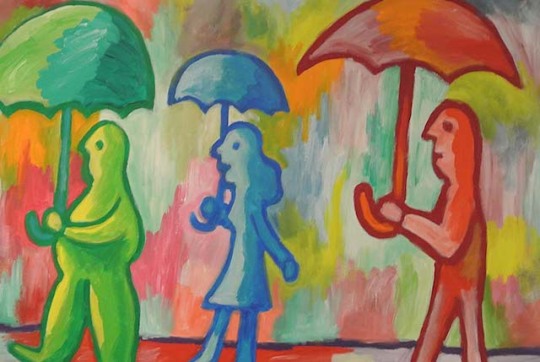
“It is quite clear to anyone of an uncluttered mental disposition that what is now put forward, quite seriously, as art by the ruling elite, is proof that seemingly rational development of a body of ideas has gone seriously awry... We address this lack of meaning, so that coherent art can be achieved and this imbalanced addressed” published on Stuckist website 2000. The work itself represents the need to cater your art to the largest audience possible and how looking for approval can ruin the artistic value in art. It also rejects the ideas of artists using their art to invoke hedonism which is described as the pursuit of pleasure.
0 notes
Text
Haegue Yang Artist Response Essay
The artwork that I have chosen to respond to is the series titled ‘Car Sick Drawings’ by the Korean artist Haegue Yang. The series of artworks includes multiple 65 x 47 cm pieces that are supposed to illustrate the journey the artist made ,which was taken via car, and was created simply by Yang dragging her pen across the paper whilst being a passenger. The artwork is supposed to serve as a visual representation of how it feels to travel when dealing with motion sickness, the jagged and wonky lines represent how it can feel as if you’re being pushed and thrown around whilst being a passenger. The artwork is also a visualisation of the journey itself and the twist and turns she took whilst driving. I really love this piece as it is so simple yet easy to understand, looking at the lines really gives a feel for what it must have been like being a passenger in the car Yang was traveling in. I also like how the lines themselves look as if they could be some sort of writing or calligraphy from far away, however on closer inspection the lines have no meaning or uniformity to them at all. “Yang has described her work as a kind of nonlinear narrative in which light, shadow and abstract forms are poetic representations of some interior monologue, emotional state, memory or yearning. Like Duras, a rootless French woman haunted by her colonial childhood in what is now Vietnam, Yang is a culturally displaced artist who was born in Seoul, educated in South Korea and Germany, exhibits everywhere (London, Frankfurt, Pittsburgh, Bilbao, Sao Paulo) and seems -- on the basis of this show, at least -- completely detached from everything but the shadows in her mind.” - Mary Abbe in her Art Review of Yang’s exhibit titled ‘INTEGRITY OF THE INSIDER’
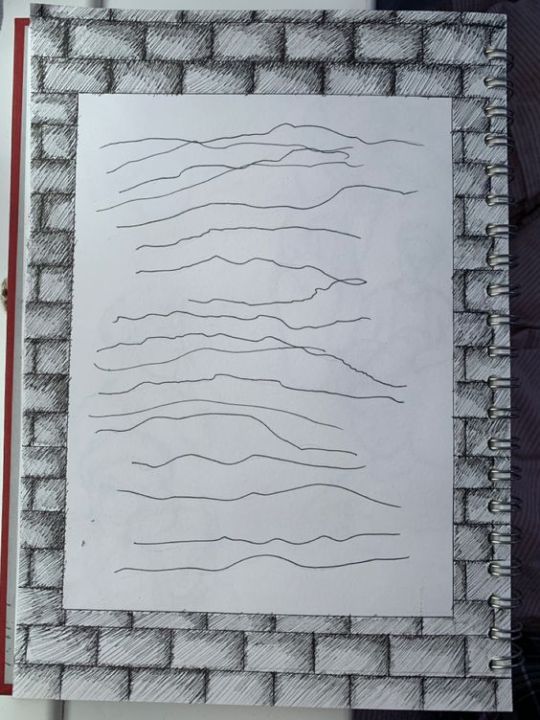
As a response to Yang’s work I wanted to create something similar with a method much like the one she used for her own exhibit, however instead of riding in a car I drew a series of lines whilst walking. After I had completed the lines I thought that the piece still needed something so I decide to draw a brick wall pattern to boarder the piece to represent the rural area I decide to take my walk in. I really enjoyed the process, drawing the lines really took away a lot of the stress that comes along with walking in a busy city in the middle of the day as I wasn’t focusing on anything or anyone around me (similarly to how the act of drawing would have helped Yang be distracted from her motion sickness therefore lessening the effect) and I found myself only focusing on the piece I was creating. It was the opposite of the derive experience as then I was more alert of my surroundings and had a good idea of where I was and where I was going to end up, but when recreating Yang’s work I was less alert and was mainly focusing on translating my movements onto the page. It was a feeling I would usually get when I was life drawing as I would drown everything else out and focus on what was in front of me (but instead of translating movements to a page it was my visuals).
0 notes
Text
Richard Long and Haegue Yang comparison
Richard Long is a British sculptor and artist who is best known for his temporary artwork that he creates with natural materials he finds on site. An example of his work is a sculpture titled ‘A Line Made by Walking’ where long created a line across a field in Wiltshire which he made by simply walking backwards and forwards in a straight line, the work itself breaks up the landscape and the open space makes the simple piece become abstract. Long talked about why he works areas like that and said that “open spaces allow (his) art to become abstract”, he also mentioned that the area in which he creates his work is just as important as the art itself. All his work is remarkably simple but is enhanced by the surrounding areas, some other examples of his work include him positioning rocks into a circle formation, pouring water to map rivers he had visited. Long mentioned how he wished his work stayed anonymous so that they would be solely be tied to the landscape and not to a person or name.
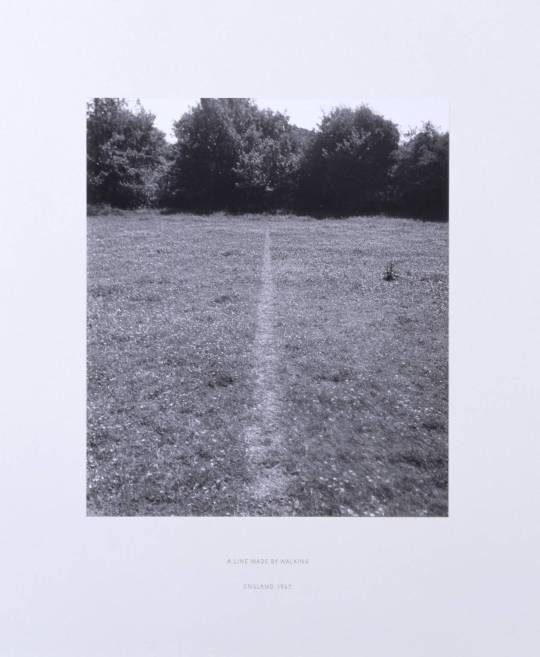
Richard Long - A Line Made by Walking
His work is representing his journey and his travels, another artist who created art around journeys is Haegue Yang. Yang created a piece titled ‘Car Sick Drawing’ which is a series of pieces that consist of a series of lines she drew whilst in the car to symbolise the way she feels when traveling, the series is part of her of her exhibition titled ‘Tracing Movements’ which showcased in South London Gallery in 2019.
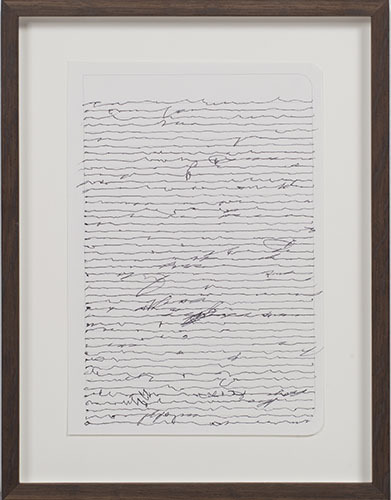
Haegue Yang - Car Sick Drawings
Yang’s work is very similar to Long’s as both artists use their pieces to document their movements and their travels, both artists use their work as a map of ,not where they travelled, but the movement they took to arrive at they’re destination. Both artist created most of their work all in one journey as Long creates his artwork whilst walking and usually stops and creates as he goes which is similar in the way the Yang created he pieces all in one car drive. They do differ in method as Long uses all-natural material which he finds along his travels whereas Yang uses ink and paper, also the location of Long’s work is incredibly import to his method whereas Yang does not.
0 notes
Text
Derive Experience Essay
The word ‘Derive’ is defined as drifting or traveling with no plan or destination and choosing your path only based on the terrain in which you are experiencing whilst traveling. During my Derive experience I ended up being drawn to the more open and nature filled areas of London and ended up in an open park, a popular spot for people in the area. This is usually my first destination when life drawing as the tall hills give an amazing view of the city with tall buildings reaching across the sky line. I had yet to see this view at that time of day (the evening) and was drawn to the idea of seeing how the landscape transformed without daylight. The lights from the windows of buildings, the car lights whizzing down the highway illuminated the scenery making it a completely different experience to view the scene in the day. Overall walking with no goal or destination help me see what I was really inspired by and what interested me about the place that I live, I found myself really able to take in my surroundings and I was able to see my town in a different light.
1 note
·
View note